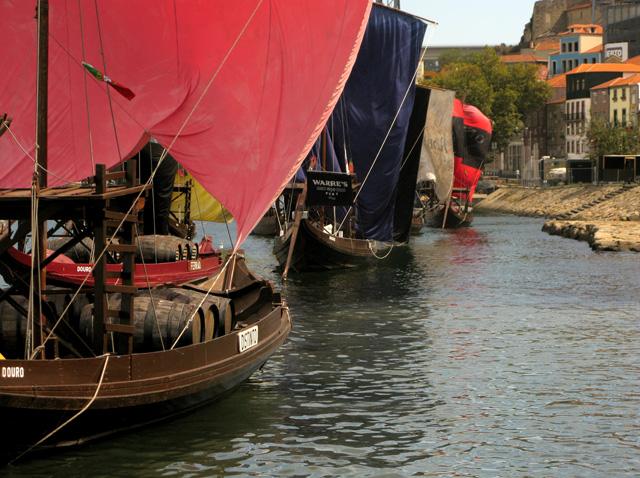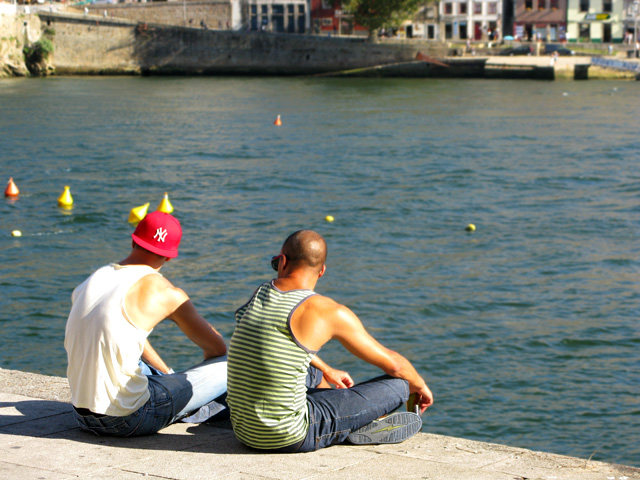 There’s a burst of Portuguese behind my left shoulder. I turn with a regretful smile ready on my face and shake my head, shrugging an apology for my lack of understanding. The old man behind me grins, crinkling his weathered face. He’s dapper and smiley and hellbent on having a chat. “Do you speak French?” he asks. “We can speak in French?”
There’s a burst of Portuguese behind my left shoulder. I turn with a regretful smile ready on my face and shake my head, shrugging an apology for my lack of understanding. The old man behind me grins, crinkling his weathered face. He’s dapper and smiley and hellbent on having a chat. “Do you speak French?” he asks. “We can speak in French?”
I smile back and reply in a broken mix of French and Italian. “Yes, a little. My Italian’s much better, though.”
His face brightens, eyes widening and eyebrows shooting up into his silver hairline. “Perfect! Un po’ d’Italiano, un peu de Francais, maybe some English,” – he pulls a face – “but I don’t like to speak English. Never have I studied it.” He grins and gives me a conspiratorial wink: “Better Francais o Italiano, no?”
His enthusiasm is infectious. So what if we don’t speak the same base language – we’ll get by in the four that we know between us, and Latin will sort the rest. Ah, Latin. Never did I realise how useful you’d be when you were killing me at school nearly 30 years ago.
We stand at the top of a set of steps leading to the port wine cellars in Vila Nova de Gaia, looking across the River Douro at the city of Porto, and talk. When one or other doesn’t understand a word we switch to another language. There’s barely a sentence goes by in which there’s only one language used, but we both relearn and relish the fact that so long as you want to communicate, it’s possible.
“Adios – arrivederci – au revoir – goodbye!” The old man wrinkles his eyes and shakes my hand. “Are you going to the river? Go down these steps – here, see – and then around the corner – et voilà! You’re there!” I wave him goodbye and hop down the steps in search of the next adventure.
Porto is a lovely city. I don’t know what I’d expected, but I’ve found myself constantly surprised. Hills and narrow winding streets lead down to the river – always to the river. It’s Porto’s lifeblood. The port wine for which Porto is famous used to be transported downriver from the vineyards in the upper reaches of the Douro valley to the cellars in Gaia via rabelo boats to be aged and then exported. The boats now transport tourists, rather than wine, but they’re still doing their part for Porto’s economy.
On a sunny day like today children wriggle in the current on the Porto side of the river along with the catfish that nibble on the algae that grows at the bottom of the high stone quay walls. The kids – rather than the fish – strip down to their underwear and run down the cobbled jetty at Rua Cais Ribiera, pulling themselves out into the water with the help of a rope that attaches a dredging crane to the quay. The current has a strong pull towards the centre of the river, and their arms work overtime, tiny muscles bulging as they edge along the rope, legs trailing behind like flotsam.
At first there are only four or five young children – the oldest maybe eight years old – but then the word gets out. More and more join the mix, and now older teenagers are appearing as well. With them comes noise and laughter and jostling. Who’s going to be braver than the rest and risk the leap from the top of the quay, 15 foot above the level of the water? A couple of thick-set, older boys swagger to the edge and look down, but retreat, laughing. At the moment it’s a game. Nobody’s really going to do it.
Are they?
There’s an excited babble of noise a little further up the quay. The younger children are huddling together, shouting and laughing. The older boys eye them up and down. You can see bravado in their eyes, covering up a sliver of doubt. Are they about to lose face to a load of kids?
The noise from the little kids’ huddle increases. They buzz with excitement, winding someone in the middle of the group up. When the buzz reaches fever-pitch and becomes a roar, she bursts out of the group like a cork from a bottle. She’s no more than 12, with long, skinny legs and no shape to her. Were it not for the long hair and stripy teeshirt knotted just under where her breasts should be, you wouldn’t know if she were male or female. Her wet hair slaps against her back as she races across the quay and launches herself into midair, chest pushing forward like a long-jumper and arms and legs windmilling as she flies clear of the stone wall.
There’s a moment of silence as everyone on the quay holds their breath.
A tourist sitting at a cafè table claps her hands to her mouth, eyes wide with horror, and half-starts to her feet.
We hear a splash from below as the girl hits the water, followed by a triumphant yell as she resurfaces. The tourist slumps with relief and the tension is broken.
The little kids jeer at the older ones, goading them to action. Now they have to jump, or lose face. With resignation in their eyes, they back away from the edge of the quay, preparing for their run-up. First one, then the other makes their running jump into the water. They have none of the grace or fiery determination of the first girl. Where she glid through the air in slow motion, they drop like stones, their weight and age working against them. It’s not important, though. There are no marks for style here. All that counts is bravery, and they’ve proved their worth. They live to dive another day.








Pingback: The Twelve Months of Twenty-Twelve » Driving Like a Maniac